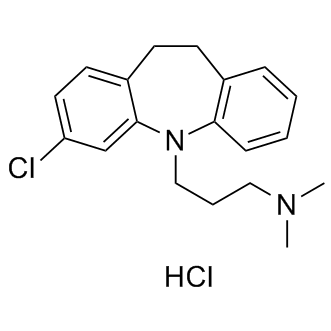| Description: |
Chlorpromazine Hydrochloride is an antagonist of the dopamine D2, 5HT2A, potassium channel andsodium channel. Chlorpromazine binds with D2 and 5HT2A with Kis of 363 nM and 8.3 nM, respectively. |
| In Vivo: |
Chlorpromazine (2 mg/kg, i.p.)-induced neurobehavioural abnormalities (NAs) are characterized by significant increase in cataleptic behaviour and loared spontaneous activity reaction time in mice[2]. Chlorpromazine (1 or 5 mg/kg, i,p.) prevents ketamine (KET) from increasing average spectral power of delta and gamma-high bands on the 5th and 10th days of treatment in rats[3]. |
| In Vitro: |
Chlorpromazine (3, 10, 20, 40, and 60 μM) decreases the peak currents of hNav1.7 in a concentration-dependent manner, with IC50 of 25.9 μM with a Hill coefficient of 2.3. Chlorpromazine (25 μM) produces strong use-dependent inhibition of the hNav1.7 current. Chlorpromazine blocks the hNav1.7 channel, independent of calmodulin[1]. Chlorpromazine blocks HERG potassium channels with an IC50 value of 21.6 μM and a Hill coefficient of 1.11. Chlorpromazine (1, 10, 100 μM) blocks HERG potassium channels expressed in Xenopus laevis oocytes in a concentration-dependent manner. Chlorpromazine blocks HERG potassium channels in the activated state[5]. |






















